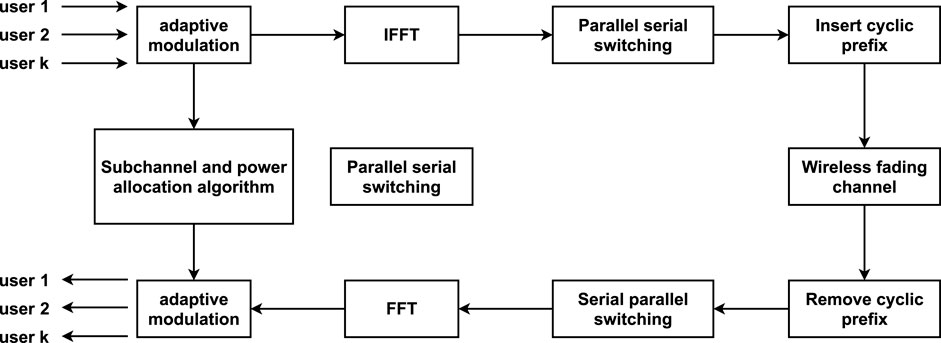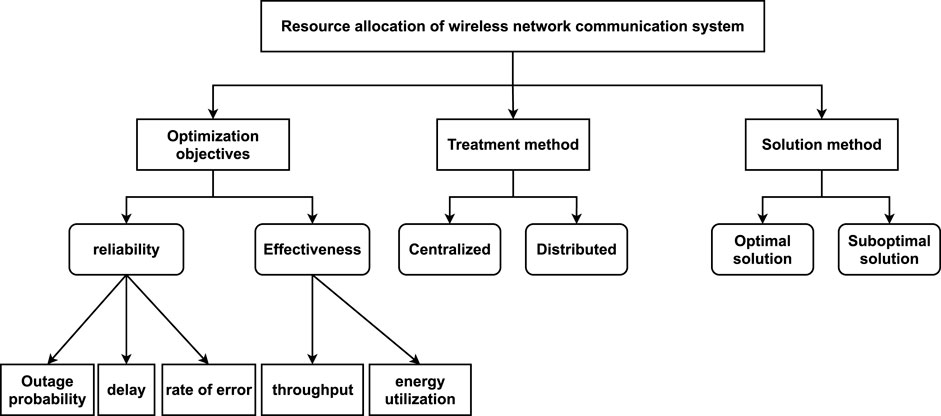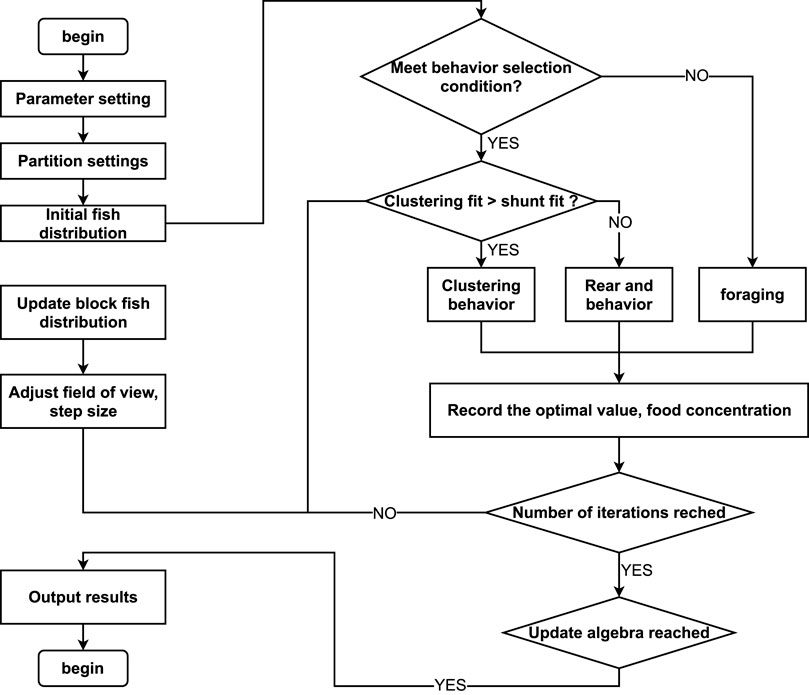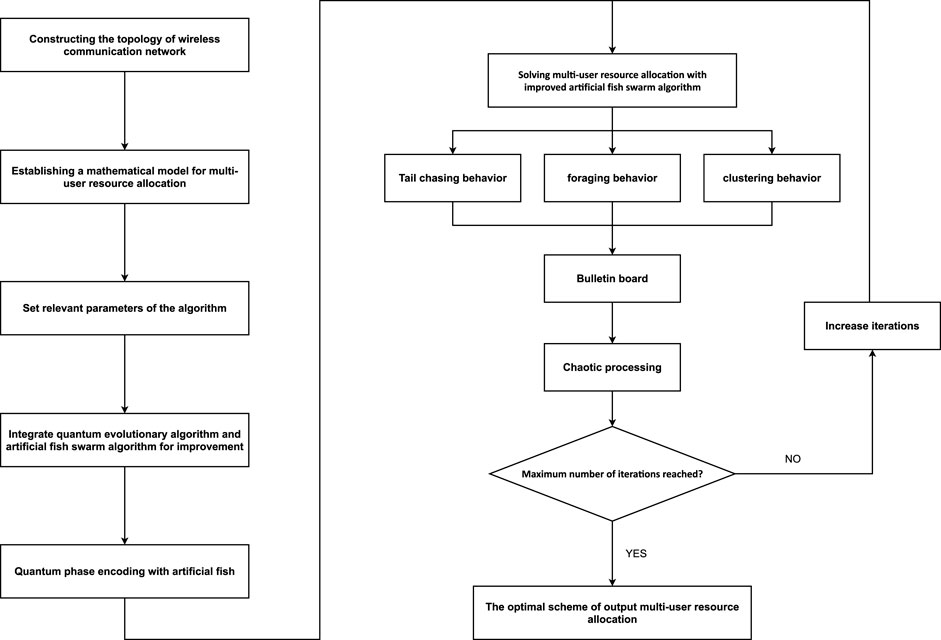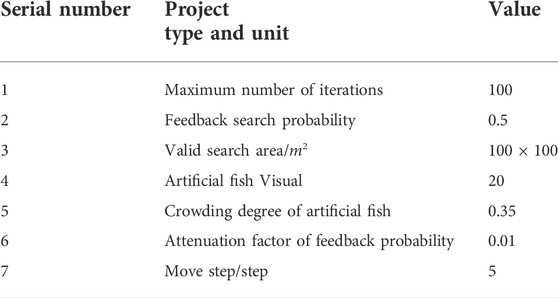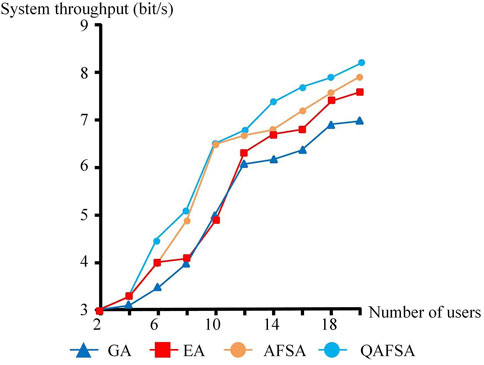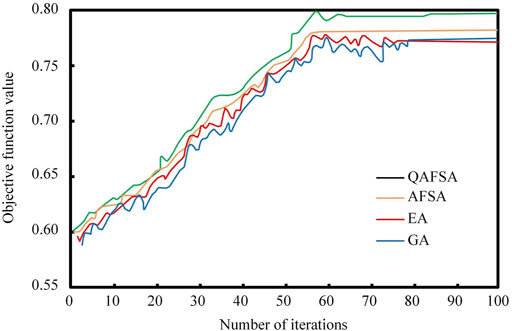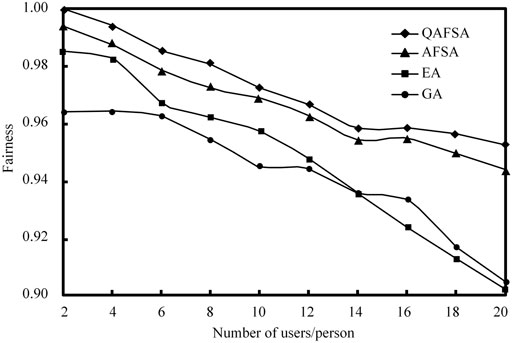- 1College of Computer and Information Science, Chongqing Normal University, Chongqing, China
- 2School of Information and Control Engineering, Qingdao University of Technology, Qingdao, Shandong, China
- 3School of Big Data and Computer Science, Chongqing College of Mobile Communication, Chongqing, China
Through in-depth research and application, it is found that with the increasing number of artificial fish, the required storage space is also increasing, which finally leads to the increasing difficulty of calculation, and the ability to obtain accurate solutions is seriously insufficient, and only satisfactory solution domains can be obtained for the system. Since the development of multi-user systems, there are still some problems in resource allocation, such as poor user fairness, low system throughput, and low system security. In view of the appeal problem, we can design a multi-user system resource allocation scheme based on quantum artificial fish swarm algorithm. Firstly, it is necessary to analyze the working principle of resource allocation in multi-user system, and establish a mathematical model according to its working principle; Furthermore, through the research and in-depth research on the artificial fish swarm algorithm, we integrate the quantum phase concept fish artificial fish swarm algorithm, introduce quantum evolutionary algorithm into the algorithm, and use quantum phase to code and improve it; Then, through simulation experiments, we compare other types of resource allocation schemes in the market, and process and analyze the experimental results; Finally, according to the experimental data, the conclusion is drawn that the improved quantum artificial fish school algorithm can accurately and quickly obtain the optimal allocation scheme, and to a certain extent, ensure user fairness, improve the communication ability of the multi-user system. Compared with other multi-user system resource allocation schemes, its overall performance is also more outstanding.
1 Wireless network communication system
1.1 Resource allocation in wireless communication
In a wireless network, it is possible to allocate and schedule the resources which are available for allocation and scheduling, such as the transmission rate, the time slot, and the antenna. The wireless resource allocation problem is how to optimize the preset parameters and maximize the resource utilization efficiency by allocating wireless resources reasonably in terms of physical conditions and QOL requirements [1]. Mathematically, this is an optimization problem. Therefore, we have to build a model for the wireless communication system [2], write restrictions on the wireless resources, and make the optimized targets based on the demand of the users. Based on the above results, we can find an appropriate resource distribution approach to optimize the resource utilization of wireless systems [3, 7].
Resource allocation involves wireless channel, multi-user diversity, user quality of service and fairness among users [8]. Among them, wireless channel has its fading phenomenon: due to the small-scale effects of multi-path fading, as well as the large-scale effects such as path loss due to distance attenuation and noise caused by obstacles, the channel has time-varying properties. It is very challenging to combat fading and interference in wireless communication [9]; The root of multi-user diversity is the independence of user channels, which is manifested in three aspects: time, frequency and space. Through effective channel allocation and multi-user scheduling, this potential gain can be used to effectively improve the system transmission efficiency; To optimize the resource allocation strategy is to improve the service quality of users; Because the resources are limited, it is impossible to fully meet the needs of users, which requires effective division of network resources and fair allocation of resources to users in the network.
1.2 Resource allocation principle of wireless network communication system
The multi-user system adopts the multi carrier modulation technology, which divides the channel into multiple orthogonal sub channels, decomposes the high-speed serial data stream into several low-speed parallel sub data blocks, transmits on multiple mutually orthogonal sub channels at the same time, and performs narrowband modulation on each sub channel. This operation reduces the mutual interference of the sub channel time, and improves the spectrum utilization. The bandwidth of the signal on each sub-channel is less than the correlation bandwidth of the channel, so the frequency selective fading on each sub-channel is flat, effectively eliminating the inter-symbol interference. In order to further improve the spectral efficiency of multi-user systems, we can obtain stronger performance in asymmetric services, and we can introduce adaptive resource allocation. The principle of adaptive resource allocation is to obtain the diversity of the system in each domain through the adaptation of bandwidth, power and rate. The main reasons for diversity [1, 10] are channel time variation, frequency selective fading, channel fading independence between multi-users, parallel sub-channels between space and frequency domain, and randomness of signal arrival. Link adaptation is the application of diversity. Its basic idea is to adaptively select the modulation order, coding method, transmission power of sub carriers, etc. according to the channel conditions of the system. The ultimate purpose of link adaptation is to improve the spectral efficiency and reliability of the system.
Three elements of mobile communication system operation: resources and resource allocation, network architecture, and information interaction. The quality of communication services often depends on the amount of allocable resources, the efficiency of resource allocation, the quality of network architecture, and the effect of information interaction. Radio resource allocation Objective: to ensure various QoS requirements of users, ensure fairness of users, and improve resource utilization efficiency of the system. The wireless network communication system uses orthogonal frequency division multiplexing technology for data communication and processing. Because the relationship between sub-channels is called positive correlation, its channels can be divided into multiple sub-channels, and each sub-channel will not interfere with each other Khan et al. [11]. Each sub-channel uses a separate and independent sub-carrier for modulation communication to achieve parallel communicatio [12]. The resource allocation principle of the wireless network communication system is shown in Figure 1, where: FFT means fast Fourier transform; IFFT represents inverse fast Fourier transform.
With the deepening of research, the problems that need to be solved by wireless resource allocation algorithms become diverse, and the strategies and methods adopted are also different. According to different standards, the algorithm classification of wireless communication network system allocation is shown in the following Figure 2:
1.3 Mathematical model of multi-purpose resource allocation in wireless network communication system
When building a mathematical model of resource allocation, It is essential to know what components are required in order to build a complete wireless communication system. In a wireless network communication system, n subcarriers exist for k users. Every user is aware of the state of the channel in the system. A subcontractor may also be assigned only to one user at a given time [13]. Then, the power assigned to the n sub carrier by the k user is Pk,n and then there is the equation for calculating the k-user’s power on the n sub channel:
Hk,n, n is the signal to noise ratio in the nth subcarrier, Γ = −Ln (4 BER)*1.4.
Reasonable allocation of sub-carriers [14] and power is the multi-user resource allocation goal of the wireless network communication system. To maximize the throughput of the wireless network communication system, the sub-carrier allocation index coefficient is defined as follows:
The multi-user resource allocation mathematical model of wireless network communication system is:
In the above equation: C1 is whether the sub-carrier is allocated or not; C2 is a sub-carrier, which can only be assigned to a unique user; C3 denotes that the power must be positiv; C4 indicates that the sub-carrier power cannot be greater than the maximum power; φi represents the user scale constraint condition; Ptot is the maximum power; Ri represents the total transmission rate of the k user, and the calculation formula is:
Where B in the formula is the bandwidth of fading channel.
2 Artificial fish swarm algorithm
2.1 Standard artificial fish swarm algorithm
The artificial fish swarm algorithm mainly shows the activity of artificial fish in the environment by simulating the four behaviors of fish-foraging behavior, crowding behavior, tail chasing behavior and random behavior. The basic activities of artificial fish are described as follows [15]:
1) Feeding behavior: Generally, fish swim freely and randomly in the water. When they find food, they will swim quickly in the direction of gradually increasing food.
2) Crowding behavior: In order to ensure their survival and avoid hazards, fish will naturally gather in groups during swimming. There are three rules for fish to follow when gathering: separation rules: try to avoid overcrowding with nearby partners; Alignment rules: try to be consistent with the average direction of neighboring partners; Cohesion rule: try to move towards the center of nearby partners.
3) Chasing behavior: When one or several fish in the school find food, their nearby partners will follow them to the food point quickly.
4) Random behavior: Individual fish usually swim randomly in the water, which is to find food points or partners in a wider range.
In this paper, a new method based on PSO is proposed in this paper, which is based on PSO, and it is used in the resource allocation. When the artificial fish in the school find food, the fish in the school can continuously adjust their location, focus on the food, and finish the location update [16]. By using this approach, we can deal with the quantity and priority of the distribution of user resources. The algorithm is made up of a parameter system and a perceptual system. The state of the artificial fish can be represented by the vector x = (x1, x2, …, xn), in which I = (1, 2, …, n) is to be optimized [17], and the amount of food at the present location of the artificial fish is represented by y = f(x), with y being an objective function;
The distance between artificial fish individuals is expressed as di,j = ‖xi − xj‖; In its perception system, the perception of artificial fish is realized by vision [18]. Through this method, the number and priority of user resource allocation can be well handled, The change of the position of the Δxi (t + 1) data list at t + 1 and t is, xi(t) represents the spatial position of the i fish, then:
Where Rand() is random data, and Step is the step of fish school position update operation.
Given that the current spatial coordinate of the i-fish is xi, the expression of the spatial coordinate xj obtained by the random movement of the fish is:
Where Visual is the visual field range value of artificial fish.
Let the food concentration in the spatial coordinates be a function of f(x), the food coordinate concentration be Fmax, the food concentration at xi be f (xi), and the food concentration at the center point xc of the fish school be f (xc). Within the range of fish movement, according to the position xj randomly assigned by Rand(), if the fish group has not found the food point, it will continue to search for food according to Eq. 6.
The current position of the i fish is Xi. According to the maximum value of f(x) within the visual range of the fish, it is determined whether the position of the food is within the visual range of the fish. If the current position xo is within the visual range of the fish, there is Eq. 9:
The current position of the i fish is xi. According to the maximum value of f(x) in the visual range, it is determined whether there are multiple food points in the visual range of the current fish. If multiple food points are visible in the current position x′s max, the fish position is updated as follows:
If |f (xc − fmax)| reach a parameter originally designed, the operation is terminated.
The above equation theory relates to the four kinds of fish groups in the AI: foraging, cluster, tail, and stochastic. These four behaviors will transform each other at different times, and this transformation is usually realized by fish from the main through their perception of the environment. All these behaviors have close relationship with the feeding and survival of the fish, and also have close relationship with solving the optimal problem.
2.2 Steps and flow chart of artificial fish swarm algorithm
The basic principle of the AI is that in the water zone, the most fish population is the one with the most nutrients in the water. Based on this property, it can simulate the behavior of the fish group, including foraging, clustering, tail chasing, randomizing, and so on, so as to realize global optimization. In the optimization process, the artificial fish may choose a few local optimum solutions, which will cause the fish to jump out of the local optimal solution, and then influence the overall optimization. Therefore, it is important to pay attention to the number of repeats in the foraging process, and to select a suitable random step, and to restrict the size of the clustering and the behavior of clustering. In order to use the AI, we first need to assign values to different types of discards, which include the population size n, the starting location of each man-made fish, the visual field of the artificial fish, the step size, the crowding factor δ, and the repetition times the trial number; The second is to calculate the fitness of the individual at the beginning of the fish colony, choose the best condition of the fish, and send the value to the bulletinship; In the course of the implementation, every person must be assessed, and the actions to be executed are chosen carefully, such as foraging prayer, swarm, tail chase, and random behavioral behavior. Then, after the artificial fish makes a choice, it will choose its location to create a new group of fish. Moreover, if the algorithm scores all the different actions, the notice board will be updated to that person; At the end, if the optimum solution on the bulletin board reaches the satisfactory error border or reaches the upper limit of the prescribed number of iterations, the algorithm terminates; otherwise, an individual assessment is made, and an appeal is executed. The detailed flow chart is shown in Figure 3.
2.3 Quantization of artificial fish swarm algorithm
A kind of quantum particle swarm optimization algorithm [19] based on the truncated mean stabilization strategy has improved the search performance of the algorithm to a certain extent, and has also improved the convergence efficiency to a certain extent. According to the salient points of its algorithm, the fish swarm algorithm studied in this study also uses its ideas on a certain basis, and has obtained good results in practical operation. In the process of quantum bit coding, fewer quantum bits are used to solve the problem of large data sets. The Born machine model [20] effectively solves this problem.
The quantizing of artificial fish is represented by the quantum phase coding, and the location of the artificial fish can be expressed more efficiently by quantum operations [21].
In the above equations, they all belong to complex numbers and exist at the same time |α|2 + |β|2 = 1, |α|2 is the probability of quantum collapse to 0 state, |β|2 is the probability of quantum collapse to 1 state. To make it easier to calculate the machine, the above equation is formed to get the corresponding matrix formula, that is:
If the matrix U conforms to the relation of U(U*)T = I, transform the above matrix to obtain:
The position of the artificial fish is described by quantum bits, so that α = cos(θ), β = sin(θ). Then Eq. 13 can be expressed as:
According to Eq. 14, the spatial position of the artificial fish is effectively quantized and encoded in the following way:
Of which θi j = 2π ⋅ rand (), rand () ∈ (0, 1), i ∈ {1, 2, …, n}, ∈ {1, 2, …, m}, n represents artificial fish total quantity, M represents the dimension decomposition number of the location of an artificial fish school in the spatial coordinate system [22]. In order to describe the location of an artificial fish colony in a multidimensional spatial coordinate system, we can get a quantum representation of the location of an artificial fish colony by a combination of Eq. 16:
Decree θ is [α, β]. For the phase of t relative to
θ meet 1 < θ ≤ 2π. Compared with Eq. 11, the artificial fish coordinate position of Eq. 13 is only θ.
A mathematical description of the location update of the artificial fish is given. In combination with Eq. 7, the update method is as follows:
In the above equation, a and B are the quintile of the i artificial fish in the j dimension at t and t + 1, and C is the position change between t and t + 1.
In order to better solve the problem of fish school position update accuracy and prevent the problem of operation time caused by too large or [23], it is necessary to adopt the dynamic phase-shift update method. At the beginning of the iteration, the phase-shift update angle is large. As the number of iterations increases, the update angle gradually decreases. The phase-shift update method for the T iteration is:
Represents a constant, and its value meets K ∈ (0, 1) the requirements. ITER represents the maximum number of iterations.
3 System resource allocation policy process
Firstly, it analyses the process of resource allocation policy, and then proposes a multi-user system resource assignment strategy based on QSAR [24]. The workflow is illustrated in Figure 4: Firstly, the topology of the system is established, and then the mathematical model of the system is established. Secondly, the parameters of the AI are set up, including the effective search area size, δ, Pfb, θ step, and max iterate [25]. In the third step, the initialization of N man-made fish is randomly formed and assembled into an group, and the location of each of the artificial fish represents a multi-user resource assignment scheme of the radio network communication system [18]. In the fourth step, the artificial fish group is quantum encoded for the sub-layer, and the four behaviors of the AI are also quantum verified. In the seventh step, the four actions of the artificial fish are realized, so that each of the artificial fish is free to pursue, feed and cluster, and the optimum location is determined. In the eighth step, a random number is generated at random, and if r < Pfb is met, a random search is performed; Otherwise, a feedback search is performed, and all fish move to the optimum location on the bulletin board; in the ninth step, the position of the currently optimum man-made fish is confused to locate the optimum location within the valid search zone. In the 10th step: save the current state of the best man-made fish on the notice board, and update the feedback search probability [24]; In the 11th step, the number of iterations is iterate = iterate + 1; Otherwise, go back to step 5 and proceed.
4 Testing of resource allocation strategy for multi-user system
4.1 Testing environment
In this paper, a comparison is made between the multi-user system resource allocation strategy and the multi-user system resource allocation strategy of GA, and the multi-user system resource allocation strategy. Table 1 shows the test environment parameters of the wireless network communication system, and the related parameters of the QSAR are given in Table 2.
4.2 Comparison and analysis of experimental data
For different numbers of users, the throughput change curve of wireless network communication system based on the multi-user system resource allocation strategy of quantum artificial fish swarm algorithm [26], in Figure 5, we can conclude from the data in Figure 5 that the amount of data which needs to be handled by the wireless network communication system also keeps increasing as the number of users increases. This is due to the fact that the data transfer rate of the wireless network communication system continues to increase as the amount of data processed by customers increases. The throughput of QRS is superior to that of artificial fish, GA, etc. This further demonstrates the superiority of QSAR in system throughput. The convergence curves of all the algorithms searching for multiuser system resources are shown in Figure 6. Compared with AI, GA, QSAR, etc, which makes it faster to solve the resource allocation scheme of multi-user system and increase the search accuracy of QGA.
In Figure 7, the fairness change curves of the distribution policies of multi-user systems are illustrated in Figure 7. The experimental data in Figure 7 show that the fairness of the wireless network communication system is reduced to varying degrees as the number of users continues to increase [27]. This is due to the fact that the average number of allocated subcarriers in the system is steadily declining as the number of users increases, which also makes it more difficult to achieve a fair distribution; However, it can be seen from the experimental data that QMI has less variation scope and better fairness than the others [13]. Compared with QSAR, the AI is less superior to QSAR in terms of fairness and the fairness of GA is the next. It also indicates that QPSO can resolve the conflict between throughput and equity, significantly increase the usage of MIMO system, satisfy the needs of users, and enhance the communication efficiency of the system.
It is well known that as time goes on, anything is going to be more and more apparent. In Figure 8, the QSAR, AI, GA, etc. As shown in Figure 8, the error rate of multi-user resource allocation continues to increase with time. As time passes, there will be some mistakes in the channel. Finally, the competition between the users gets stronger and stronger, which causes the error rate to evolve in an upward direction. It is shown that QSAR, AIS, GA will have different levels as time goes by, but QSAR is more slow than the other QSAR, GA. Based on the graph, the algorithm of the Quantum Artificial Fish Swarm is roughly equal to 0.8. The QSAR algorithm is not an optimal multiuser resource allocation algorithm, so it is necessary to study it further.
To sum up, aiming at the problems of poor user fairness and small system capacity of the current multi-user system resource allocation strategy, in this paper, we present a new strategy for multi-user system resource allocation based on QSAR. First, this paper analyses the working principle of the multi-user system resource distribution, builds up the mathematical model, and then carries on the quantizing and coding of the artificial fish Swarm algorithm to compute the resource distribution model. Based on the test results, we find that the multi-user system resource allocation strategy based on this approach is fairly fair, improves the throughput of the multi-user system, speeds up the data transmission speed, reduces the error rate of the multi-user system resource allocation, and is better than other multi-user system resource allocation strategies, it has broad application prospects.
5 Expectation
The arrival of the Internet era has accelerated a new round of social revolution. It has made people change a lot in society and changed human beings completely. With the progress of society and the constant updating of the times, the resource allocation strategy of multi-user system will develop in a better and better direction, and will play a vital role in the future computer field. In the future, the computer field will develop towards the goal of faster, higher and better. It is essential to pursue efficient data transmission. Therefore, the application of quantum is the trend of future development. Quantum will be applied to different computer technology research, and play a huge role in a small body. In order to solve the problem that the system is not fair and the system capacity is small, a new kind of multiuser resource allocation scheme is proposed in this paper. With the existence of this method, it has better fairness, improves the throughput of multi-user system, accelerates the data transmission speed, and has a good development prospect in the future. However, at present, scientists’ research on quantum is not very in-depth, and the estimation of the role of quantum in the future is unknown. Therefore, in future research, it is hoped that more and more scholars can contact this field and make corresponding achievements in this field.
Data availability statement
The raw data supporting the conclusions of this article will be made available by the authors, without undue reservation.
Author contributions
All authors have the same contribution in participating in research article and work support.
Funding
The National Natural Science Foundation of China (Nos. 61772295, 61572270, and 61173056). The PHD foundation of Chongqing Normal University (No. 19XLB003). The Science and Technology Research Program of Chongqing Municipal Education Commission (Grant No. KJZD-M202000501). Chongqing Technology Innovation and application development special general project (cstc2020jscx-lyjsAX0002).
Acknowledgments
Upon the completion of this thesis, I could not stop expressing my heartfelt appreciation and great gratitude to those who have contributed to the thesis.
Conflict of interest
The authors declare that the research was conducted in the absence of any commercial or financial relationships that could be construed as a potential conflict of interest.
Publisher’s note
All claims expressed in this article are solely those of the authors and do not necessarily represent those of their affiliated organizations, or those of the publisher, the editors and the reviewers. Any product that may be evaluated in this article, or claim that may be made by its manufacturer, is not guaranteed or endorsed by the publisher.
References
1. Cao H, Tang L, Li J, Fang X. Resource allocation algorithm for the downlink of multi-user ofdm system based on fairness. ICST (Institute for Computer Sciences, Social-Informatics and Telecommunications Engineering (2015).
2. Yang G, Hu F, Hou J. The multi-user detection for the mimo-ofdm system based on the genetic simulated annealing algorithm. In: Proceedings. The 2009 international workshop on information security and application (IWISA 2009) (citeseer) (2009). p. 334.
3. Zidan M, Abdel-Aty A-H, El-Sadek A, Zanaty E, Abdel-Aty M. Low-cost autonomous perceptron neural network inspired by quantum computation. In: AIP conference proceedings. AIP Publishing LLC (2017). Vol. 1905:020005.
4. Zidan M., Abdel-Aty A, Younes A, Zanaty E, El-Khayat I, Abdel-Aty M. A novel algorithm based on entanglement measurement for improving speed of quantum algorithms. Appl Math Inf Sci (2018) 12:265–9. doi:10.18576/amis/120127
5. Said T, Chouikh A, Bennai M. N two-transmon-qubit quantum logic gates realized in a circuit qed system. Appl Math Inf Sci (2019) 13:839–46. doi:10.18576/amis/130518
6. Abdel-Aty A-H, Kadry H, Zidan M, Al-Sbou Y, Zanaty E, Abdel-Aty M. A quantum classification algorithm for classification incomplete patterns based on entanglement measure. J Intell Fuzzy Syst (2020) 38:2809–16. doi:10.3233/jifs-179566
7. Zidan M, Aldulaimi S, Eleuch H. Analysis of the quantum algorithm based on entanglement measure for classifying boolean multivariate function into novel hidden classes: Revisited. App Mat Inf Sci (2021) 15:643–7. doi:10.18576/amis/150513
8. Yang Y, Luan Y. Performance comparison of user detections for mc-cdma system. Electronic Science and Technology (2010).
9. Luo B, Sun Z. Enabling end-to-end communication between wireless sensor networks and the internet based on 6lowpan. Chin J Electron (2016) 24:633–8. doi:10.1049/cje.2015.07.033
10. Teng Z, Xie L, Xian Y, Xu Z, Chu Y, University ND. Resource allocation strategy for multi-user ofdm systems based on genetic algorithm. J Hunan Univ Sci Technology(Natural Sci Edition) (2018).
11. Khan HZ, Ali M, Rashid I, Ghafoor A, Naeem M, Khan AA, et al. Resource allocation for energy efficiency optimization in uplink-downlink decoupled 5g heterogeneous networks. Int J Commun Syst (2021) 34. doi:10.1002/dac.4925
12. Zhang J, Zhang J, Dong JP, Zhao SI. A genetic algorithm based subcarrier and antennaallocation in multiuser mimo-ofdm system. J Shanghai Norm Univ (Natural Sciences) (2009).
13. Liu M, Zhang F, Ma Y, Pota HR, Shen W. Evacuation path optimization based on quantum ant colony algorithm. Adv Eng Inform (2016) 30:259–67. doi:10.1016/j.aei.2016.04.005
14. Chen B, Li Y, Tao G, Peng L, Liu X. A resource allocation algorithm based on subcarrier pairing in multi-user cooperative relay communication. Telecommunications Sci (2014) 2011:691–702.
15. D T, J W. Pmsm parameter identification based on artificial fish swarm algorithm. Journal of Hangzhou University of Electronic Science and Technology (Natural Science Edition (2021).
16. Neshat M, Sepidnam G, Sargolzaei M, Toosi AN. Artificial fish swarm algorithm: A survey of the state-of-the-art, hybridization, combinatorial and indicative applications. Artif Intell Rev (2014) 42:965–97. doi:10.1007/s10462-012-9342-2
17. Wu Y, Gao X-Z, Zenger K. Knowledge-based artificial fish-swarm algorithm. IFAC Proc volumes (2011) 44:14705–10. doi:10.3182/20110828-6-it-1002.02813
18. Guobi L, Hongjun Y. Optimization of svr prediction model based on improved artificial fish swarm algorithm. J Huaiyin Normal Univ (NATURAL SCIENCE EDITION) (2020) 19:6.
19. Gong L-H, Xiang L-Z, Liu S-H, Zhou N-R. Born machine model based on matrix product state quantum circuit. Physica A: Stat Mech its Appl (2022) 593:126907. doi:10.1016/j.physa.2022.126907
20. Zhou N-R, Liu X-X, Chen Y-L, Du N-S. Quantum k-nearest-neighbor image classification algorithm based on kl transform. Int J Theor Phys (2021) 60:1209–24. doi:10.1007/s10773-021-04747-7
21. Hongyang R. Prediction of flotation concentrate grade and recovery based on improved artificial fish swarm algorithm, 2. Liaoning University of science and Technology (2021).
22. Yang H, Du T, Wu J, Liu X, Wenwu LI. Solving high dimensional and complex non-convex programming based on improved quantum artificial fish algorithm. Open Automation Control Syst J (2014) 6:129–37. doi:10.2174/1874444301406010129
23. Du T, Hu Y, Ke X. Improved quantum artificial fish algorithm application to distributed network considering distributed generation. Comput Intell Neurosci (2015) 2015:1–13. doi:10.1155/2015/851863
24. Guo Y, Wu X, Huang W, Wang H. Adaptive minimum entropy blind equalization algorithm based on quantum artificial fish swarm optimization. J Syst Simulation (2016).
25. Ye T-Y, Geng M-J, Xu T-J, Chen Y. Efficient semiquantum key distribution based on single photons in both polarization and spatial-mode degrees of freedom. Quan Inf Process (2022) 21:123–1. doi:10.1007/s11128-022-03457-1
26. Ye T-Y, Li H-K, Hu J-L. Semi-quantum key distribution with single photons in both polarization and spatial-mode degree. Int J Theor Phys (2020) 59(9):2807–15. doi:10.48550/arXiv.2205.06813
Keywords: quantity resource allocation method, multi user system, user fairness, quantum artificial fish swarm algorithm, system capacity
Citation: Dong Y, Xu Q, Fu Y, Jia F and Nian Z (2022) An improved quantum artificial fish swarm algorithm for resource allocation in multi-user system. Front. Phys. 10:1042806. doi: 10.3389/fphy.2022.1042806
Received: 13 September 2022; Accepted: 04 October 2022;
Published: 11 November 2022.
Edited by:
Tianyu Ye, Zhejiang Gongshang University, ChinaCopyright © 2022 Dong, Xu, Fu, Jia and Nian. This is an open-access article distributed under the terms of the Creative Commons Attribution License (CC BY). The use, distribution or reproduction in other forums is permitted, provided the original author(s) and the copyright owner(s) are credited and that the original publication in this journal is cited, in accordance with accepted academic practice. No use, distribution or reproduction is permitted which does not comply with these terms.
*Correspondence: Yumin Dong, ZHltQGNxbnUuZWR1LmNu
 Yumin Dong
Yumin Dong Qian Xu1
Qian Xu1